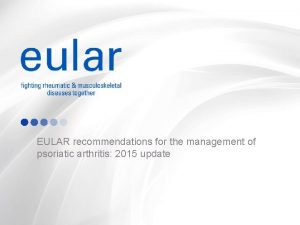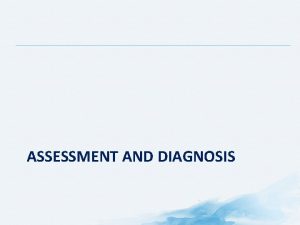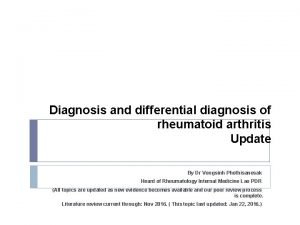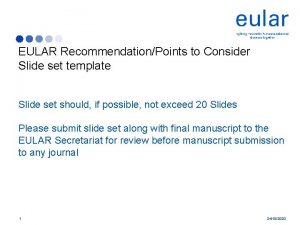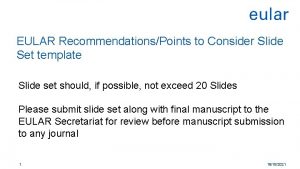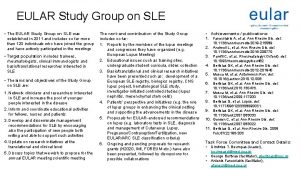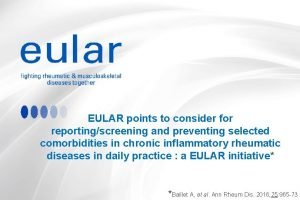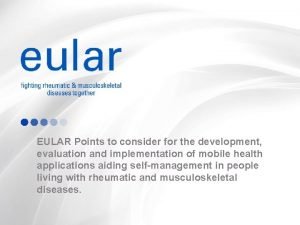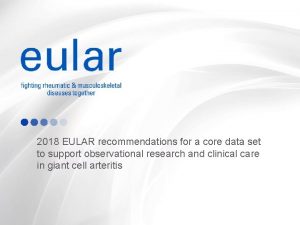EULAR RecommendationPoints to Consider Slide set template Slide
















- Slides: 16

EULAR Recommendation/Points to Consider Slide set template Slide set should, if possible, not exceed 20 Slides Please submit slide set along with final manuscript to the EULAR Secretariat for review before manuscript submission to any journal 1 22/02/2021

EULAR recommendations for the management of rheumatoid arthritis – 2019 Update

Slide 1: Target population/question • To update the EULAR recommendations for the management of RA which was first developed in 2010 and last updated in 2016 • The target populations are rheumatologists and other health professionals treating patients with RA; patients with rheumatoid arthritis; payers; regulators; hospital administrators; politicians 3 22/02/2021

Slide 2: Methods/methodological approach • Methods: According to the EULAR Standardized Operating Procedures* Consensual approach Systematic literature research Consensual approach FINAL Recommendations * van der Heijde et al Ann Rheum Dis 2016, 75: 3 -15 4 22/02/2021

Overarching principles A-C Overarching principles 2019 5 A. Treatment of RA patients should aim at the best care and must be based on a shared decision between the patient and the rheumatologist. B. Treatment decisions are based on disease activity and other patient factors, such as progression of structural damage, comorbidities and safety issues. C. Rheumatologists are the specialists who should primarily care for RA patients. 22/02/2021

Overarching Principles D-E 6 D. Patients require access to multiple drugs with different modes of action to address the heterogeneity of RA; they may require multiple successive therapies throughout life. E. RA incurs high individual, medical and societal costs, all of which should be considered in its management by the treating rheumatologist. 22/02/2021

Individual Recommendations 1 -4 Recommendations 1 -5 – 2019 7 1. Therapy with DMARDs should be started as soon as the diagnosis of RA is made. (A) 2. Treatment should be aimed at reaching a target of sustained remission or low disease activity in every patient. (A) 3. Monitoring should be frequent in active disease (every 1 -3 months); if there is no improvement by at most 3 months after the start of treatment or the target has not been reached by 6 months, therapy should be adjusted. (B) 4. MTX should be part of the first treatment strategy. (A) 22/02/2021

Individual Recommendations 5 -8 8 5. In patients with a contraindication to MTX (or early intolerance), leflunomide or sulfasalazine should be considered as part of the (first) treatment strategy. (A) 6. Short term glucocorticoids should be considered when initiating or changing cs. DMARDs, in different dose regimens and routes of administration, but should be tapered as rapidly as clinically feasible. (A) 7. If the treatment target is not achieved with the first cs. DMARD strategy, in the absence of poor prognostic factors, other cs. DMARDs should be considered. (D) 8. If the treatment target is not achieved with the first cs. DMARD strategy, when poor prognostic factors are present, a b. DMARD or a ts. DMARD should be added. (A) 22/02/2021

Individual Recommendations 9 -12 9. b. DMARDs and ts. DMARDs should be combined with a cs. DMARD; in patients who cannot use cs. DMARDs as comedication, IL-6 pathway in-hibitors and ts. DMARDs may have some ad-vantages compared to other b. DMARDs. (A) 10. If a b. DMARD or ts. DMARD has failed, treatment with another b. DMARD or a ts. DMARD should be considered; if one TNF inhibitor therapy has failed, patients may receive an agent with another mode of action or a second TNF inhibitor. (A) If a patient is in persistent remission after having tapered glucocorticoids, one can consider tapering b. DMARDs or ts. DMARD, especially if this treatment is combined with a cs. DMARD. (A) 11. 12. 9 If a patient is in persistent remission, tapering the cs. DMARD could be considered. (B) 22/02/2021

Slide 16: Summary Table Oxford Level of Evidence • Strength of recommendation are indicated next to each recommendation § Recommendations 1 -6 and 8 -11 : Strength A (based on highest lkevel of evidence) § Recommendation 7: Strength D (based primarily on expert opinion) § Recommendation 12: Strength B (based on lower level of evidence from trials with higher risk of bias) 10 22/02/2021

Summary of Recommendations (1) • Several recommendations of the 2016 update remained unchanged § No evidence has accrued that any of these may be wrong, on the contrary § EULAR recommendations have achieved a “steady state of art“ regarding the definition of the treatment target (REM/LDA; ACREULAR definitions), therapeutic strategy (T 2 T), initial therapy, and stratification for the next treatment phase § “Imaging remission“ is out § 3 trials show just the same: no better outcomes, but more costs and more risks 11 22/02/2021

Summary of Recommendations (2) • More data are available today than 3 years ago regarding long-term efficacy and risks of ts. DMARDs (Jak-inhibitors) § Now placed at a similar level as b. DMARDs across phase II (cs. DMARD-IR) and phase III (b/ts. DMARD-IR) § Caveat: H. zoster (esp. Japan, Korea), VTE/PE (patients at high risk) • Increasing evidence that stopping b. DMARDs/ts. DMARDs is associated with flares, especially when there is residual disease activity § Dose reduction and interval increase should only be done in sustained stringent (ACR-EULAR) remission; cautious withdrawal § No reason to taper cs. DMARDs while continuing b. DMARDs/ ts. DMARDs - the reverse is indicated because of similar outcome, less costs and better safety. 12 22/02/2021

Summary of Recommendations in lay format Recommendation * People should be prescribed a DMARD as soon as they are diagnosed with rheumatoid arthritis **** Every person’s treatment aim should be sustained remission or low disease activity **** Your rheumatoid arthritis should be monitored every 1– 3 months; treatment should be adjusted if there is no improvement after 3 months, or if your target has not been reached by 6 months *** Methotrexate should be part of your first treatment strategy **** Leflunomide or sulfasalazine should be considered instead of methotrexate for people who cannot take it, or who have side effects **** 1 star (*) means it is a weak recommendation with limited scientific evidence; 2 stars (**) means it is a weak recommendation with some scientific evidence; 3 stars (***) means it is a strong recommendation with quite a lot of scientific evidence; 4 stars (****) means it is a strong recommendation supported with a lot of scientific evidence. Recommendations with just 1 or 2 stars are based mainly on expert opinion and not backed up by appropriate clinical studies, but may be as important as those with 3 and 4 stars. 13 22/02/2021

Summary of Recommendations in lay format Recommendation * You may need to take steroids when you start or change your cs. DMARDs, but they should be used for short periods of time **** If you do not reach your target with the first cs. DMARD, and there are no other factors, a different cs. DMARD should be tried * If you do not reach your target with the first cs. DMARD, and there are other factors affecting your disease, a b. DMARD or ts. DMARD should be added to your treatment **** b. DMARDs and ts. DMARDs should be combined with a cs. DMARD; if you cannot use cs. DMARDs, you may be offered IL-6 inhibitors or ts. DMARDs instead */**** 1 star (*) means it is a weak recommendation with limited scientific evidence; 2 stars (**) means it is a weak recommendation with some scientific evidence; 3 stars (***) means it is a strong recommendation with quite a lot of scientific evidence; 4 stars (****) means it is a strong recommendation supported with a lot of scientific evidence. Recommendations with just 1 or 2 stars are based mainly on expert opinion and not backed up by appropriate clinical studies, but may be as important as those with 3 and 4 stars. 14 22/02/2021

Summary of Recommendations in lay format Recommendation * If a b. DMARD or ts. DMARD has not worked, you can try a different b. DMARD or a ts. DMARD; if one TNF inhibitor has failed, you can try another TNF, or a treatment with a different mode of action **** If you get persistent remission after stopping steroids, you can also **** consider reducing your dose of b. DMARDs or ts. DMARDs, especially if you are also taking a cs. DMARD If your disease is in persistent remission, you might be able to reduce your cs. DMARD dose *** 1 star (*) means it is a weak recommendation with limited scientific evidence; 2 stars (**) means it is a weak recommendation with some scientific evidence; 3 stars (***) means it is a strong recommendation with quite a lot of scientific evidence; 4 stars (****) means it is a strong recommendation supported with a lot of scientific evidence. Recommendations with just 1 or 2 stars are based mainly on expert opinion and not backed up by appropriate clinical studies, but may be as important as those with 3 and 4 stars. 15 22/02/2021

Acknowledgements • Steering Committee: Johannes Bijlsma, Gerd Burmester, Maxime Dougados, Iain Mc. Innes, Ronald van Vollenhoven, Maarten de Wit, Désirée van der Heijde • Fellows: Andreas Kerschbaumer (Efficacy), Alexandre Sepriano (Safety) • Expanded Task Force: Rheumatologists from Europe: Daniel Aletaha, Martin Aringer, Johan Askling, Alejandro Balsa, Maarten Boers, Alfons den Broeder, Maya Buch, Frank Buttgereit, Roberto Caporali, Mario Cardiel, Diederik de Cock, Catalin Codreanu, Maurizio Cutolo, Christopher J. Edwards, Paul Emery, Axel Finckh, Laure Gossec, Jacques-Eric Gottenberg, Merete L. Hetland, Tom Huizinga, Xavier Mariette, Ulf Müller-Ladner, Jose Pereira da Silva, Gyula Poór, Andrea Rubbert-Roth, Anja Strangfeld, René Westhovens; Rheumatologists from overseas: Mario Cardiel, Zhanguo Li, Eduardo Mysler, Janet Pope, Kenneth Saag, Tsutomu Takeuchi • Health professionals: Yvonne van Eijk-Hustings, Adeline Ruyssen-Witrand • Patients: Marios Kouloumas, Marieke Voshaar 16 22/02/2021
 Total set awareness set consideration set
Total set awareness set consideration set Training set validation set test set
Training set validation set test set Gossec
Gossec Eular graph
Eular graph Oa grade 2
Oa grade 2 Eular
Eular Rheumatoid nodules
Rheumatoid nodules Acr eular criteria for ra
Acr eular criteria for ra Eular
Eular Heel and toe step
Heel and toe step Bounded set vs centered set
Bounded set vs centered set Fuzzy logic
Fuzzy logic Crisp set vs fuzzy set
Crisp set vs fuzzy set Crisp set vs fuzzy set
Crisp set vs fuzzy set What is the overlap of data set 1 and data set 2?
What is the overlap of data set 1 and data set 2? Surjective vs injective
Surjective vs injective Langkah-langkah mengaktifkan microsoft publisher
Langkah-langkah mengaktifkan microsoft publisher


